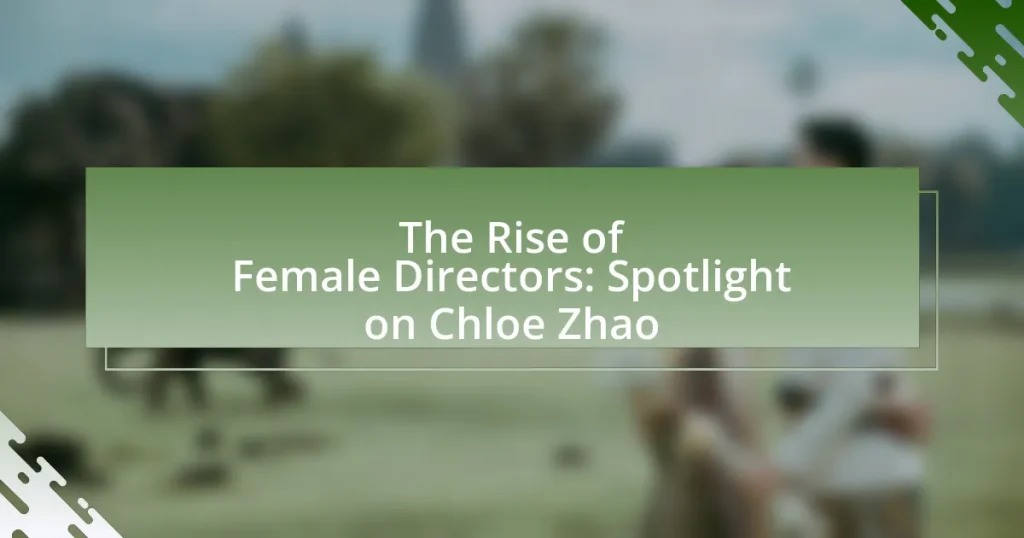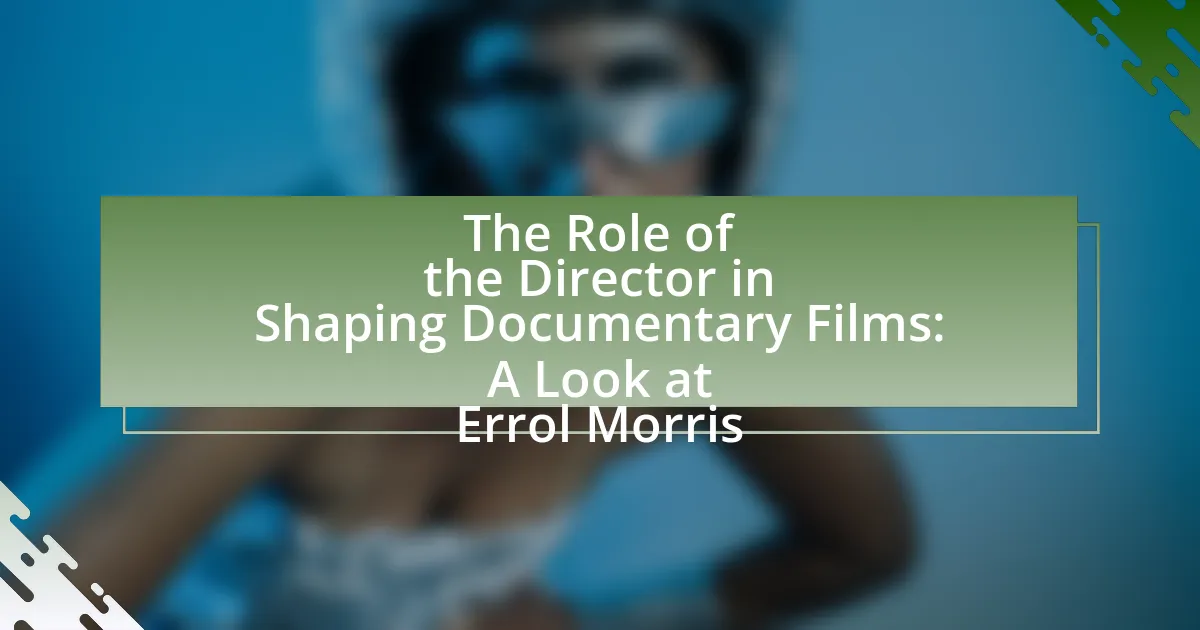The article focuses on the rise of female directors in the film industry, with a particular emphasis on Chloe Zhao as a pivotal figure in this movement. It highlights the significance of increased representation of women in directorial roles, showcasing statistics that demonstrate the growth of female directors over the years. The article discusses the barriers these directors have historically faced, the unique perspectives they bring to storytelling, and the impact of Zhao’s work on the cinematic landscape. Additionally, it explores the themes commonly addressed by female directors and offers insights into the challenges Zhao encounters in a male-dominated industry, along with strategies for aspiring female filmmakers to find their voice.

What is the significance of the rise of female directors in the film industry?
The rise of female directors in the film industry is significant as it promotes diversity, challenges traditional narratives, and enhances representation in storytelling. Female directors, such as Chloe Zhao, have gained recognition for their unique perspectives, contributing to a broader range of stories that resonate with diverse audiences. For instance, Zhao’s film “Nomadland” won multiple Academy Awards, including Best Director, highlighting the impact of female leadership in filmmaking. This shift not only empowers women in a historically male-dominated industry but also encourages the exploration of themes that reflect women’s experiences, ultimately enriching the cinematic landscape.
How has the representation of female directors changed over the years?
The representation of female directors has significantly increased over the years, particularly in the 21st century. In 2007, only 7% of directors for the top 250 grossing films were women, while by 2021, this figure rose to 18%, according to the Center for the Study of Women in Television and Film. This upward trend reflects a growing recognition of female talent in the industry, highlighted by achievements such as Chloe Zhao winning the Academy Award for Best Director in 2021 for “Nomadland,” making her the second woman and the first woman of color to win this award. The increase in female directors is also supported by initiatives aimed at promoting gender equality in filmmaking, further contributing to the changing landscape of representation in the industry.
What statistics highlight the growth of female directors in Hollywood?
The percentage of female directors in Hollywood has significantly increased, with women directing 16% of the top 100 grossing films in 2021, up from 12% in 2020. Additionally, a report from the Center for the Study of Women in Television and Film indicates that the number of female directors working on films has nearly doubled from 2015 to 2021. In 2020, women directed 18% of films in the top 250, compared to just 4% in 2009. These statistics demonstrate a clear upward trend in the representation of female directors in the industry.
What barriers have female directors faced historically?
Female directors have historically faced significant barriers including gender discrimination, lack of access to funding, and limited opportunities in a male-dominated industry. Gender discrimination has manifested in hiring practices that favor male directors, resulting in women directing only 12% of the top 250 grossing films in 2019, according to a study by the Center for the Study of Women in Television and Film. Additionally, female directors often encounter challenges in securing financing for their projects, as investors may be less likely to back films directed by women. This systemic bias has contributed to a persistent underrepresentation of women in directorial roles throughout the history of cinema.
Why is Chloe Zhao a pivotal figure in this movement?
Chloe Zhao is a pivotal figure in the movement of female directors due to her groundbreaking achievements in the film industry, particularly with her Academy Award-winning film “Nomadland.” This film not only showcased her unique storytelling style that blends documentary and narrative techniques but also highlighted the experiences of marginalized communities, thereby expanding the representation of women and diverse voices in cinema. Zhao’s success at major film festivals and her recognition by the Academy have set a precedent for future female filmmakers, demonstrating that women can excel in traditionally male-dominated spaces. Her work has inspired a new generation of female directors to pursue their visions and challenge industry norms.
What are Chloe Zhao’s notable achievements in filmmaking?
Chloe Zhao’s notable achievements in filmmaking include winning the Academy Award for Best Director for her film “Nomadland” in 2021, making her the second woman and the first woman of color to receive this honor. Additionally, “Nomadland” also won the Academy Award for Best Picture and Best Actress for Frances McDormand, showcasing Zhao’s ability to create critically acclaimed work. Her earlier film, “The Rider,” received significant recognition, including nominations at the Cannes Film Festival, further establishing her reputation in the industry. Zhao’s unique storytelling style, often blending documentary and narrative techniques, has garnered her numerous accolades and a distinct place in contemporary cinema.
How has Chloe Zhao’s background influenced her directorial style?
Chloe Zhao’s background has significantly influenced her directorial style by integrating her multicultural experiences and personal narratives into her films. Growing up in China and later moving to the United States, Zhao’s unique perspective allows her to blend Eastern and Western storytelling techniques, which is evident in her films like “Nomadland” and “The Rider.” Her emphasis on authenticity and the portrayal of marginalized communities stems from her own experiences as an outsider, which she captures through naturalistic cinematography and character-driven narratives. This approach has garnered critical acclaim, as seen in her winning the Academy Award for Best Director, making her the first woman of color to achieve this honor.
What impact does the rise of female directors have on storytelling in cinema?
The rise of female directors significantly enriches storytelling in cinema by introducing diverse perspectives and narratives that challenge traditional norms. Female directors often bring unique life experiences and viewpoints, which can lead to more nuanced character development and storytelling techniques. For instance, films directed by women, such as Chloe Zhao’s “Nomadland,” have garnered critical acclaim for their authentic portrayal of marginalized communities and emotional depth, showcasing how female directors can reshape cinematic narratives. This shift is supported by statistics indicating that films directed by women tend to feature more complex female characters and explore themes of identity and resilience, thereby broadening the scope of storytelling in the industry.
How do female directors bring unique perspectives to their films?
Female directors bring unique perspectives to their films by incorporating diverse narratives and experiences that often reflect underrepresented voices. For instance, Chloe Zhao’s work in “Nomadland” highlights themes of resilience and community among marginalized groups, showcasing a storytelling approach that emphasizes empathy and authenticity. Research indicates that films directed by women tend to feature more complex female characters and explore social issues from different angles, as seen in the 2020 report by the Geena Davis Institute on Gender in Media, which found that female directors are more likely to include female protagonists and address gender equality. This distinct viewpoint enriches the cinematic landscape and fosters a broader understanding of human experiences.
What themes are commonly explored by female directors like Chloe Zhao?
Female directors like Chloe Zhao commonly explore themes of identity, belonging, and the human connection to nature. Zhao’s film “Nomadland” exemplifies this by portraying the life of a woman who embraces a nomadic lifestyle in the American West, highlighting themes of resilience and community among marginalized individuals. Additionally, female directors often delve into the complexities of gender and cultural identity, as seen in Zhao’s work, which reflects her own experiences as a Chinese-American filmmaker. These thematic explorations resonate with audiences and contribute to a broader understanding of diverse narratives in cinema.
How does Chloe Zhao’s work reflect broader trends in female-directed films?
Chloe Zhao’s work exemplifies broader trends in female-directed films by emphasizing authentic storytelling and diverse representation. Her films, such as “Nomadland,” highlight marginalized voices and explore themes of resilience and community, aligning with the increasing focus on inclusivity in female-directed cinema. This trend is supported by the success of female directors at major film festivals and award shows, where films by women have gained critical acclaim and recognition, reflecting a shift in the industry towards valuing unique perspectives. Zhao’s approach not only showcases the capabilities of female filmmakers but also contributes to a growing body of work that challenges traditional narratives and promotes social awareness.
What challenges does Chloe Zhao face as a female director in a male-dominated industry?
Chloe Zhao faces significant challenges as a female director in a male-dominated industry, including gender bias, limited access to funding, and fewer networking opportunities. Gender bias manifests in the form of skepticism regarding her capabilities and the authenticity of her storytelling, often leading to a lack of support from industry gatekeepers. Limited access to funding is evidenced by the fact that female directors receive a disproportionately small percentage of film financing; in 2020, only 16% of directors of the top 100 grossing films were women. Additionally, Zhao encounters fewer networking opportunities, as male directors often dominate industry events and decision-making roles, which can hinder her ability to connect with influential producers and collaborators. These challenges collectively impact her ability to secure projects and gain recognition in a competitive landscape.
What can aspiring female directors learn from Chloe Zhao’s career?
Aspiring female directors can learn the importance of authentic storytelling and representation from Chloe Zhao’s career. Zhao’s films, such as “Nomadland,” emphasize real-life experiences and marginalized voices, showcasing the power of personal narratives in cinema. Her success at the Academy Awards, where she became the first woman of color to win Best Director, highlights the significance of perseverance and staying true to one’s vision in a predominantly male industry. Additionally, Zhao’s approach to collaboration with non-professional actors demonstrates the value of inclusivity and community in filmmaking, encouraging aspiring directors to seek diverse perspectives in their work.
What strategies did Chloe Zhao use to overcome obstacles in her career?
Chloe Zhao employed several strategies to overcome obstacles in her career, including embracing her unique perspective as a filmmaker and leveraging her independent filmmaking background. By focusing on authentic storytelling that reflects her experiences as a Chinese immigrant in America, Zhao created films that resonate with diverse audiences. Her breakthrough film, “Nomadland,” which won multiple Academy Awards, exemplifies her ability to blend personal narrative with broader social themes, showcasing her talent and vision. Additionally, Zhao’s commitment to collaboration with non-professional actors and real-life communities in her projects has allowed her to create genuine connections and portray authentic experiences, further solidifying her place in the film industry.
How can emerging female filmmakers find their voice in the industry?
Emerging female filmmakers can find their voice in the industry by actively participating in film festivals, networking with industry professionals, and leveraging social media platforms to showcase their work. Engaging in film festivals, such as Sundance or Tribeca, provides opportunities for exposure and feedback, while networking can lead to collaborations and mentorships that are crucial for career development. Additionally, utilizing social media allows filmmakers to build an audience and share their unique perspectives, which is essential in a competitive landscape. According to a 2021 report by the Center for the Study of Women in Television and Film, films directed by women received more attention and funding when showcased at prominent festivals, highlighting the importance of visibility in establishing a voice.




